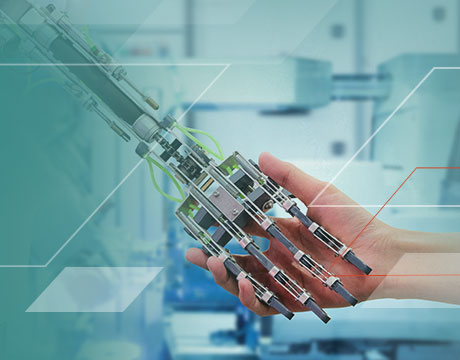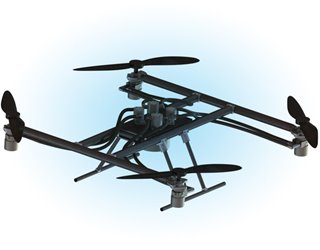Robotic Blog: Are Hydraulics the Future of Heavy-Lift Drones?
Robotic Blog: Are Hydraulics the Future of Heavy-Lift Drones?


A prime perk of writing this blog is talking with engineers who turn established paradigms on their head. Take, for example, hydraulic power. Most engineers think of big, slow systems, like construction cranes, tractors, metal stampers, and other heavy industrial equipment.
Not Lizhi Shang. The post-doctoral researcher at Purdue University’s Maha Fluid Power Research Center—America’s largest fluid power lab—believes hydraulic power is the future of drones. And not just any drones. Shang believes hydraulic’s combination of low weight and high power density makes it ideal for large cargo or passenger drones.
The idea popped into Shang’s head when he visited the Oshkosh Air Show, a popular showcase for experimental aircraft. There, he saw Workhorse’s SureFly, a two-person quadcopter. It uses a piston engine two drive the two electrical generators that power the rotor motors. In essence, Shang said, the electrical system acted as a transmission to control the speed of the motors.
That got Shang thinking: “I know hydraulic has advantages over electrical systems. Its high fluid pressure generates very high power density. And hydraulic motors are about half the weight of electric motors for same power output.”
You May Also Like: Unique Gas Turbine Engine Powers Quieter, More Reliable Drones
He envisioned a quadcopter powered by a piston or turbine engine. To demonstrate the concept, he began building a 2-meter-long prototype on a budget.
Rather a piston engine, he started with a corded lightweight electric motor. It drives a central off-the-shelf axel-piston pump. He chose one made for aircraft, an application that is pushing the boundaries of low mass-high power hydraulic systems.
The pump presented a problem, however: it was too powerful. At full speed, it could spin the propellers at 10-12,000 rpm. That is so fast—greater than the speed of sound—that it reduces the amount of lift. So, he limits the pump to 30 percent of its rated speed, which lets him run the propellers at a more efficient 2-3,000 rpm. The pump sends pressurized fluid to four tooth-sized (5 cm3 displacement) hydraulic motors, one for each propeller.
Editor’s Pick: Flying on Mars
The controller proved the most difficult part of the project.
“Hydraulic systems are not unpredictable, but they are not so straight forward either,” Shang said. To control the drone’s flight, he needed a system that could drive each propeller at different speeds. This has been done commercially.
More critical was the challenge of residual pressure. In an electric drone, turning the power off shuts down the motor. In hydraulic systems, turning off the power leaves residual pressure in the system. This could make it difficult to maneuver the drone when it must adjust to changing winds or less than ideal weather. Shang has developed some control strategies but needs to verify them in demonstration flights.
Changing the hardware may help. He could, for example, buy a better sized main pump and reduce weight without sacrificing power.
He could also use more sophisticated hydraulic motors for the propellers. Some models let the control system change the amount of fluid displaced during each stroke. This would give Shang more (and faster) control over propeller speed.
Ultimately, Shang hopes to develop heavy lift drones to deliver cargo over long distances to emergencies, remote areas, and offshore to oil rigs and ship. He has patented the technology and seeks to license it or collaborate with corporate partners while continuing to develop it.
Recommended for You: Inspection Robots: Something to Prove
Shang also has a second goal for the project. This is to raise the awareness of hydraulics as an interesting field for engineers who want to work on advanced applications.
“Many people believe it is old technology—not efficient and not so smart,” he said. “So, now we are trying to take it to some smart place and show what a state-of-the-art hydraulic system can do.”
Which would certainly turn an established paradigm on its head.
Alan S. Brown is Senior Editor.
Not Lizhi Shang. The post-doctoral researcher at Purdue University’s Maha Fluid Power Research Center—America’s largest fluid power lab—believes hydraulic power is the future of drones. And not just any drones. Shang believes hydraulic’s combination of low weight and high power density makes it ideal for large cargo or passenger drones.
The idea popped into Shang’s head when he visited the Oshkosh Air Show, a popular showcase for experimental aircraft. There, he saw Workhorse’s SureFly, a two-person quadcopter. It uses a piston engine two drive the two electrical generators that power the rotor motors. In essence, Shang said, the electrical system acted as a transmission to control the speed of the motors.
That got Shang thinking: “I know hydraulic has advantages over electrical systems. Its high fluid pressure generates very high power density. And hydraulic motors are about half the weight of electric motors for same power output.”
You May Also Like: Unique Gas Turbine Engine Powers Quieter, More Reliable Drones
He envisioned a quadcopter powered by a piston or turbine engine. To demonstrate the concept, he began building a 2-meter-long prototype on a budget.
Rather a piston engine, he started with a corded lightweight electric motor. It drives a central off-the-shelf axel-piston pump. He chose one made for aircraft, an application that is pushing the boundaries of low mass-high power hydraulic systems.
The pump presented a problem, however: it was too powerful. At full speed, it could spin the propellers at 10-12,000 rpm. That is so fast—greater than the speed of sound—that it reduces the amount of lift. So, he limits the pump to 30 percent of its rated speed, which lets him run the propellers at a more efficient 2-3,000 rpm. The pump sends pressurized fluid to four tooth-sized (5 cm3 displacement) hydraulic motors, one for each propeller.
Editor’s Pick: Flying on Mars
The controller proved the most difficult part of the project.
“Hydraulic systems are not unpredictable, but they are not so straight forward either,” Shang said. To control the drone’s flight, he needed a system that could drive each propeller at different speeds. This has been done commercially.
More critical was the challenge of residual pressure. In an electric drone, turning the power off shuts down the motor. In hydraulic systems, turning off the power leaves residual pressure in the system. This could make it difficult to maneuver the drone when it must adjust to changing winds or less than ideal weather. Shang has developed some control strategies but needs to verify them in demonstration flights.
Changing the hardware may help. He could, for example, buy a better sized main pump and reduce weight without sacrificing power.
He could also use more sophisticated hydraulic motors for the propellers. Some models let the control system change the amount of fluid displaced during each stroke. This would give Shang more (and faster) control over propeller speed.
Ultimately, Shang hopes to develop heavy lift drones to deliver cargo over long distances to emergencies, remote areas, and offshore to oil rigs and ship. He has patented the technology and seeks to license it or collaborate with corporate partners while continuing to develop it.
Recommended for You: Inspection Robots: Something to Prove
Shang also has a second goal for the project. This is to raise the awareness of hydraulics as an interesting field for engineers who want to work on advanced applications.
“Many people believe it is old technology—not efficient and not so smart,” he said. “So, now we are trying to take it to some smart place and show what a state-of-the-art hydraulic system can do.”
Which would certainly turn an established paradigm on its head.
Alan S. Brown is Senior Editor.




